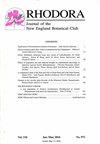The Globally Rare Aldrovanda vesiculosa (Droseraceae) New to New Hampshire, U.S.A.
IF 0.2
4区 生物学
Q4 PLANT SCIENCES
引用次数: 0
Abstract
Aldrovanda vesiculosa L. (Droseraceae), the waterwheel plant, is a globally rare submerged aquatic carnivorous plant with extraordinarily fast-closing snap-traps and a highly specific suite of ecological requirements (Cross 2012). Plants are perennial, freefloating, and rootless, with linear, sparsely branched stems bearing whorls of 4–9 leaves terminated by bristles and a solitary, bi-lobed trap. The species is fast growing under optimal conditions and reproduction is predominantly clonal through the detachment of branches during favorable summer conditions (Adamec 1999). Plants overwinter by forming vegetative dormant turions at their apices in autumn. This stenotopic species usually grows in shallow, standing, dystrophic waters (Adamec 2018). The species is native to Europe, Africa, Asia, and Australia yet, due to recent rapid habitat degradation and population decline, nearly 90% of its historic occurrences are extinct, leaving only 50 natural sites remaining worldwide (Cross 2012). This critically endangered plant, with its novel aquatic carnivorous habit, has long been venerated by carnivorous plant hobbyists. Consequently, plants have been propagated and successfully introduced into many waterbodies in countries where it is not native. Deliberate introductions (or so-called assisted migration/colonization events) have become a more recent conservation tool for Aldrovanda vesiculosa (Adamec 2005; Cross 2012). About 30 artificial sites are known in Europe, Asia, and North America. Introductions (from Japanese sources) into the eastern United States first established the species in Virginia, and then subsequently into New Jersey and New York (Lamont et al. 2013). We report here on an assisted colonization effort, via a known carnivorous plant hobbyist, that led to an established population of Aldrovanda vesiculosa var. vesiculosa in southern New Hampshire. This represents the first documented occurrence of the species in New England and is its most northern station in North America. Plants of Japanese origin were deposited by the aforementioned hobbyist into a waterbody in Pelham, New Hampshire, in ca. 2010 in the hopes of establishing another locality for this imperiled species. The initial visit to the New Hampshire site in July 2017 confirmed the population survived, but in summer 2018 plants were not located. Plants were again observed in 2019 (Matthew Charpentier, Oxbow Associates Inc., pers. comm.). Annual美国新罕布什尔州新发现的全球罕见的Aldrovanda vesiculosa(Droseraceae)。
水轮植物Aldrovanda vesiculosa L. (Droseraceae),水轮植物,是一种全球罕见的水下水生食肉植物,具有非常快速关闭的捕集器和高度特定的生态要求(Cross 2012)。植物多年生,自由漂浮,无根,线性,稀疏分枝的茎上有4-9叶的轮生,由刚毛终止,单生,双裂的陷。该物种在最佳条件下生长迅速,在有利的夏季条件下通过分支分离繁殖主要是无性系(Adamec 1999)。植物在秋季通过在其顶端形成营养休眠环来越冬。这种狭窄的物种通常生长在浅的、静止的、营养不良的水域(Adamec 2018)。该物种原产于欧洲、非洲、亚洲和澳大利亚,但由于最近栖息地的迅速退化和数量的减少,近90%的历史物种已经灭绝,世界范围内仅剩下50个自然地点(Cross 2012)。这种极度濒危的植物,以其新颖的水生食肉习性,长期以来一直受到食肉植物爱好者的尊敬。因此,植物已经繁殖并成功地引入了许多非原生国家的水体。有意引进(或所谓的辅助迁移/殖民化事件)已成为最近的保护工具,以保护水藻(Adamec 2005;跨越2012年)。在欧洲、亚洲和北美大约有30个已知的人工遗址。从日本引进到美国东部,首先在弗吉尼亚州建立了该物种,随后进入新泽西州和纽约州(Lamont et al. 2013)。我们在这里报告一个辅助的殖民化努力,通过一个已知的肉食性植物爱好者,导致了在新罕布什尔州南部建立了一个种群的vesiculosa var. vesiculosa。这是该物种在新英格兰首次有记录的出现,也是其在北美最北的站点。大约在2010年,上述的业余爱好者将日本的植物放入了新罕布什尔州佩勒姆的一个水体中,希望为这种濒危物种建立另一个地方。2017年7月对新罕布什尔州遗址的首次访问证实,该种群存活了下来,但在2018年夏季,没有找到植物。2019年再次观察到植物(Matthew Charpentier, Oxbow Associates Inc., pers.)。通讯)。年度
本文章由计算机程序翻译,如有差异,请以英文原文为准。
求助全文
约1分钟内获得全文
求助全文
来源期刊

Rhodora
生物-植物科学
CiteScore
0.40
自引率
0.00%
发文量
40
审稿时长
>12 weeks
期刊介绍:
This peer-reviewed journal is devoted primarily to the botany of North America and accepts scientific papers and notes relating to the systematics, floristics, ecology, paleobotany, or conservation biology of this or floristically related regions.
 求助内容:
求助内容: 应助结果提醒方式:
应助结果提醒方式:


